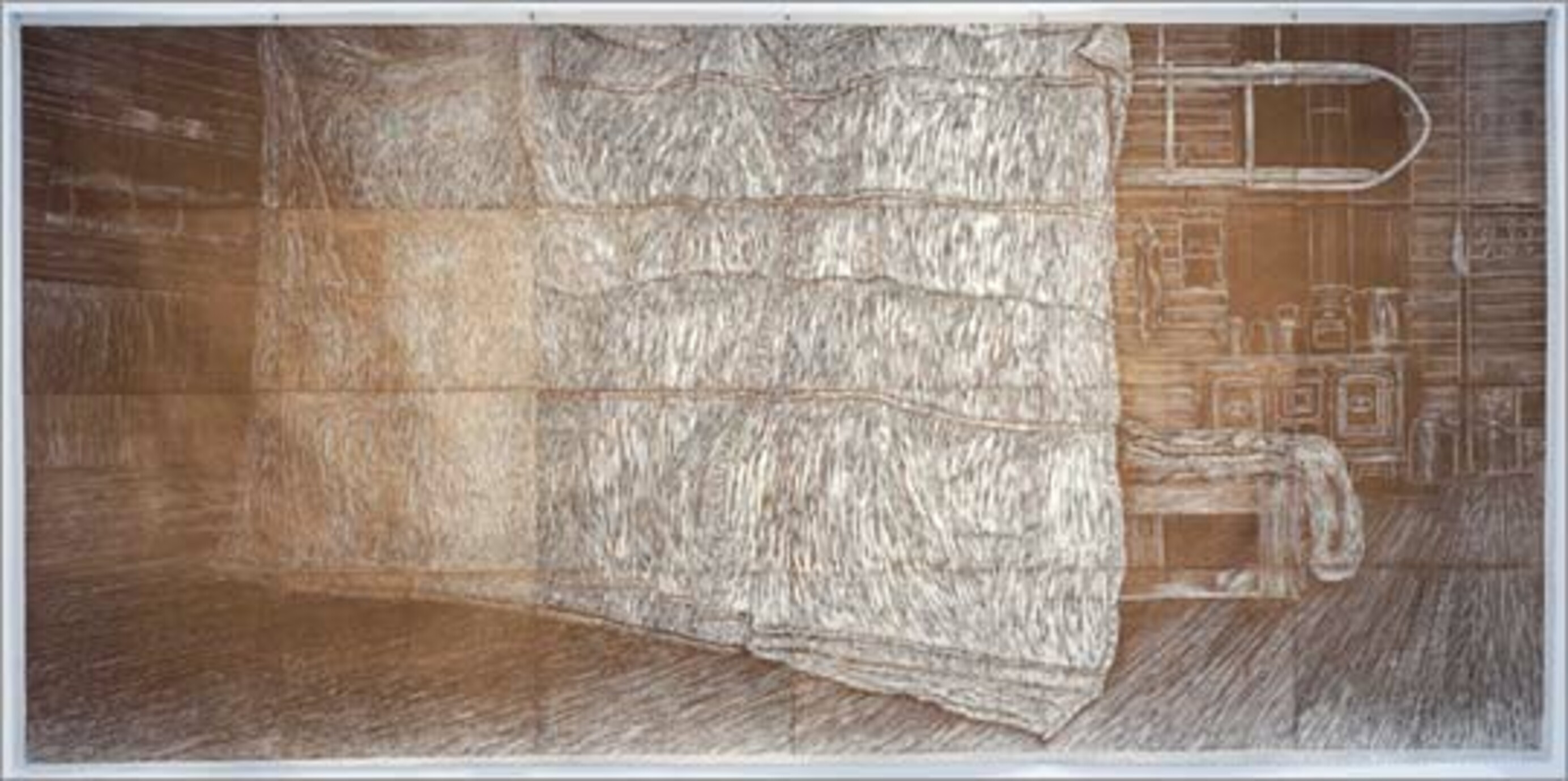This exhibition is now closed
A Standing Place
9 April –
1 August 2004

Denise Copland A standing place 2002-2003. Woodcut on treated canvas
An installation by Denise Copland, drawing on her experiences of the frozen wilderness that is Antarctica.
Local artist Denise Copland talks to curator Peter Vangioni about her new installation at the Gallery, and her experiences on the ice as an Antarctic Arts Fellow.
What areas of Antarctica did you visit during your time as an Antarctic Arts Fellow?
On Ross Island, I went to Scott Base, into the Imax crevasse, and Scott and Shackleton historic hut sites at Hut Point, as well as Cape Evans and Cape Royds. On the main Antarctic continent, I visited the Dry Valleys and Cape Geology.
What effect did your visit to the region have on your work?
I gained a deeper physical and psychological 'reading' of the unique environment, which strengthened the underlying concepts of my work and influenced the processes and materials I used in the installation A Standing Place.
Were there any features of the Antarctic landscape that particularly inspired you?
The sea's frozen surface and the tracery of patterns within caused by the continuous cycle of freeze and thaw, the enormous pressure created by sea's movement and ultimately the collision of the ice with the land – all this gave me much to draw from and contemplate. The tones of white and blue reflected from the surfaces of land and sea, punctuated by the greys of the distant Trans-Antarctic mountains, was inspiring. Also, the contrasts of the atmospheric conditions (24-hour sunlight and then the ferocity of a blizzard I was very lucky to have witnessed) and spaces (the confinements of the historic huts and expanses of the frozen environment) continue to influence my thinking and work.
The extreme cold of Antarctica would have presumably placed certain limitations or challenges on your working methods. How did you deal with these challenges?
I was taken out of my comfort zone and into the unknown, resulting in new ways of working, thinking and responding to elements of chance and change. Prior to my trip, and with the aid of my fridge's freeze box, I experimented with various drawing and print media. This helped me to anticipate which media would withstand the cold conditions I would encounter on the ice. I took only the media and materials that would not contaminate or damage the near pristine environment – for example, prepared metal plates, woodboard, mylar and tinted papers. In this regard, Antarctica New Zealand staff were extremely helpful and accommodating of my requirements.
Human endeavour and interaction with the environment has been a recurring theme in your work. You have continued this theme in A Standing Place, in particular focusing on Ernest Shackleton's expeditions to Antarctica. How have you explored or developed a narrative of Shackleton's involvement with Antarctica?
Of all the research undertaken on Antarctica, the accounts of explorers and scientists of the Heroic Age inspired me, in particular Sir Ernest Shackleton. He had the leadership qualities, inner reserves and character needed to survive isolation and the extremes of nature. In my view, Antarctica was his standing place, a place he mapped with his eyes, body, mind and writing – hence the title of this installation and the works within it. Visiting Antarctica allowed me to stand where he stood, to get a glimpse of what he may have faced, and to make drawings of the physical marks he left behind.
A Standing Place breaks away from traditional printmaking practices and includes several three-dimensional artworks. Do you see this as an important element/development in your work?
The questions that arose in this installation, and the underlying concepts, to a degree dictated which direction the work might take. Three-dimensional elements were essential. My aim was to try and capture something of the delicate and unfathomable aspects I had experienced in Antarctica; for example, the glowing light, and what lay above and below the surface on which I stood – the shadow signatures within these frames of reference. The lightbox and use of three dimensions seemed appropriate for this.
To convey Antarctica's vastness, its chilling climatic changes and its essence in a confined space was a challenge. The concepts, placements and mapping of the works within this space were carefully considered: the four works entitled A standing place at the north end of the gallery touch on human elements, such as Shackleton; the large embossed work entitled a lure of little voices at the opposite end alludes to the visual and physical transience and mysterious nature of Antarctica, with which Shackleton was so absorbed. The larger freeze and thaw lightbox alludes to the frozen sea I stepped on to (and flew over) and over which Shackleton trekked in his journey to the South Pole.
Denise Copland was one of three 2001–2 Antarctic Arts Fellows, and has been a practicing artist since 1978. She lives and works in Christchurch.
The artist would like to acknowledge Antarctic New Zealand and Creative New Zealand for their generous support in funding the Artists to Antarctic Programme. A Standing Place is dedicated to Sir Ernest Shackleton, explorer.
Peter Vangioni is Curator (Works on Paper) at the Christchurch Art Gallery.
(Extract from Bulletin 137 June – August 2004)
Exhibition number: 716
